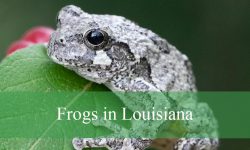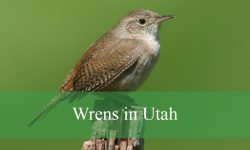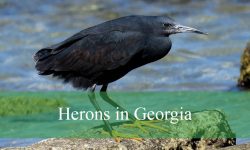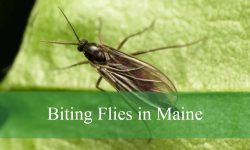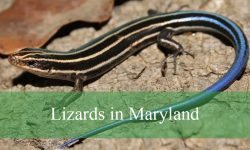Nestled in the diverse landscapes of the Natural State, the birds of Arkansas paint a vivid tapestry of avian life. From the forests of the Ozark Mountains to the wetlands of the Mississippi Delta, Arkansas hosts an impressive variety of bird species.
Birdwatchers and nature enthusiasts flock to this region to witness the seasonal migrations, vibrant songbirds, and majestic raptors that call Arkansas home.
With its rich habitats and commitment to conservation, Arkansas offers a sanctuary for both common and rare bird species, making it a premier destination for birding adventures.
Different Common Birds of Arkansas
American Crow
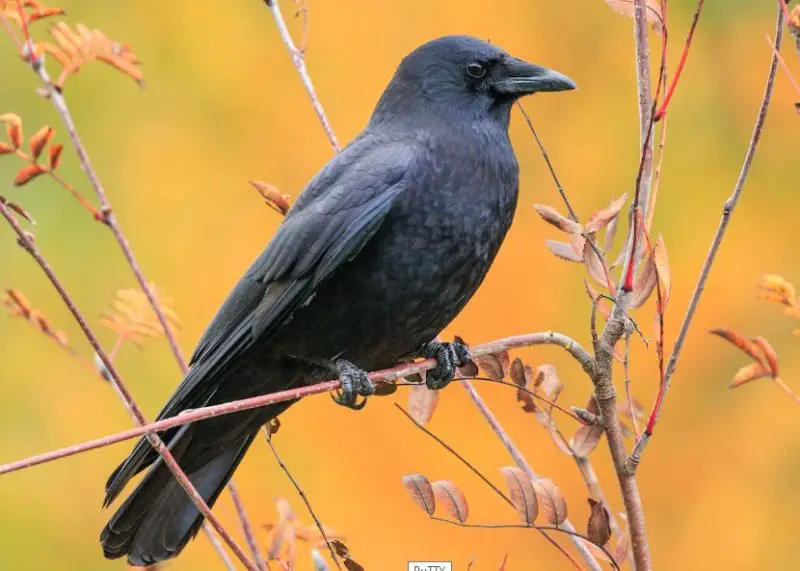
The American Crow, a large, entirely black bird with an iridescent sheen, is a common sight across various habitats in Arkansas. Easily recognizable by its long black bill, legs, and feet, this adaptable species can be found in woodlands, fields, urban areas, and even landfills.
While not frequent feeder visitors, they can be attracted to peanuts, whole kernel corn, and suet. American Crows are renowned for their intelligence and are capable of using tools, solving problems, and recognizing human faces.
Their diverse vocal repertoire includes caws, rattles, cackles, and clicks, with the most common call being a distinctive “caw-caw.” These smart, versatile birds add an intriguing element to Arkansas’s avian population.
Song Sparrow
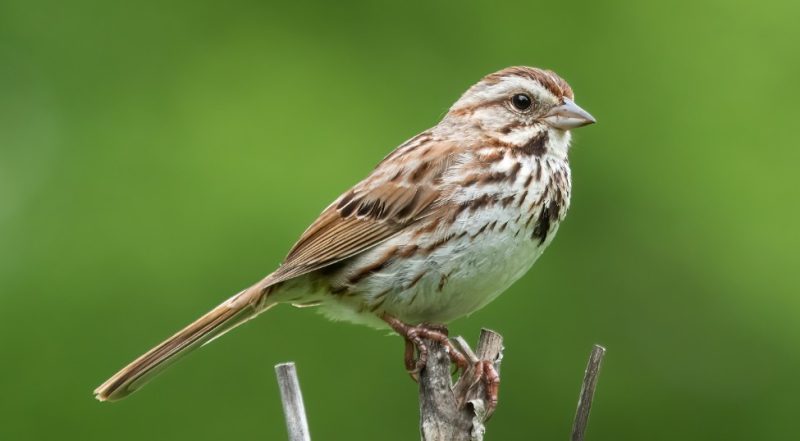
The Song Sparrow, a common sight in Arkansas’s wet, shrubby, and open areas, is distinguishable among similar sparrow species. Its key features include a chest with brown streaks converging to a central breast spot, a brown crown with a grey middle stripe, and a grey eyebrow and cheek.
The body is predominantly rust-brown with grey streaks. Unlike tree-nesting birds, Song Sparrows often nest in weeds, grasses, or directly on the ground.
Their beautiful song, typically consisting of three short notes followed by a pretty trill, varies by location and individual bird. This melodious call, combined with their distinctive markings, makes the Song Sparrow a delightful and identifiable presence in Arkansas’s diverse landscapes.
White-breasted Nuthatch
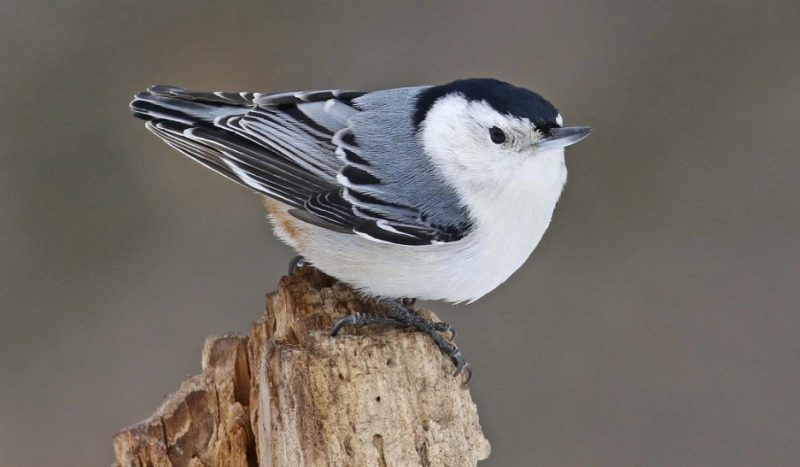
The White-breasted Nuthatch, a common sight in Arkansas’s deciduous forests and wooded areas, is a compact bird with distinctive features. Both sexes share a blue-gray back, white cheeks and chest, with males sporting a black cap and females sporting a lighter, gray crown.
These birds have no visible neck, a short tail, and a long, pointy bill. Adaptable to human presence, they frequent parks, cemeteries, and backyard feeders, attracted by sunflower seeds, peanuts, suet, and mealworms.
Their unique vocalization, a repetitive “yank” call, is easily identifiable. White-breasted Nuthatches add charm to Arkansas’s wooded landscapes with their agile movements and distinctive appearance.
Red-winged Blackbird
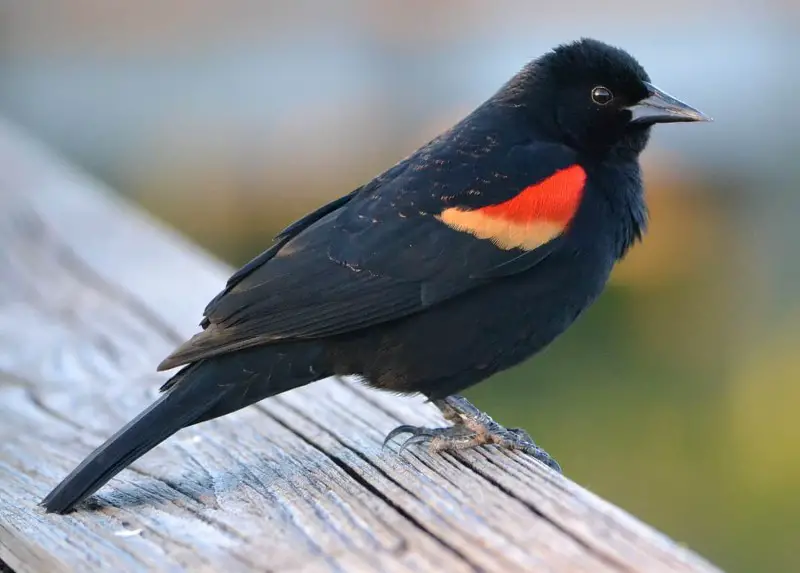
The Red-winged Blackbird is a distinctive species in Arkansas, easily identified by its unique features. Males are predominantly black with striking red and yellow shoulder patches, while females are brown with heavy streaking and a hint of yellow around the bill. Both sexes have conical bills and are often seen perched on cattails or high in trees.
During breeding season, they inhabit marshes and wet areas, with males aggressively defending nests built by females in dense vegetation. In non-breeding seasons, they flock to grasslands and fields, often mixing with other blackbird species.
Their rich, musical “conk-la-ree!” song is a familiar sound in Arkansas wetlands during spring, signaling their presence and breeding activities.
European Starling
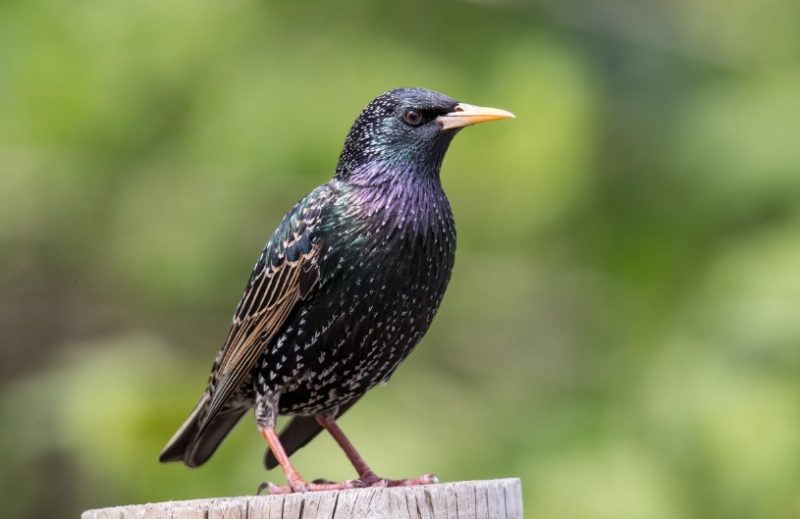
The European Starling, a common sight in Arkansas, is about the size of an American Robin with glossy black plumage. Characterized by a short tail and long, slender beak, breeding adults display darker feathers with a green-purple sheen. In winter, they lose their glossiness, develop white spots, and their beaks darken.
Interestingly, this invasive species was introduced to North America in 1890, when 100 birds were released in New York’s Central Park. Their remarkable adaptability to urban environments and omnivorous diet have led to their widespread proliferation, often outcompeting native bird species.
While small numbers can be entertaining to observe, large flocks can become problematic at bird feeders, aggressively displacing other birds and consuming large amounts of food. Effective strategies are often needed to manage their presence in backyard bird-feeding areas.
Brown-headed Cowbird
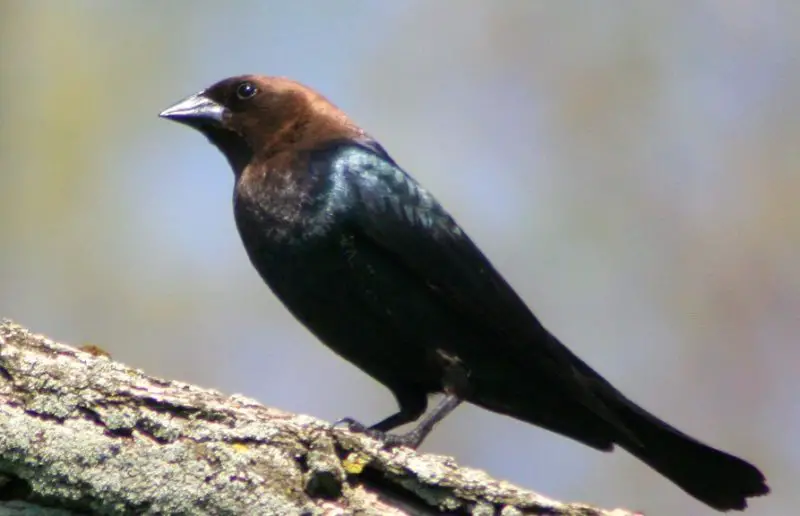
The Brown-headed Cowbird, a stocky blackbird with a thick, conical bill, is a common sight in Arkansas. Males are easily identifiable by their black bodies and brown heads, though the head color may appear dark in poor light. Females are plain brown with slight belly streaking and black eyes.
Originally inhabitants of grasslands and woodland edges, they’ve adapted well to human-altered landscapes. These birds are notorious “brood parasites,” laying eggs in other species’ nests.
Found in various habitats, from prairies to residential areas, their presence is often signaled by their distinctive song – a gurgling, liquid-sounding “glug glug glee.” Their unique reproductive strategy and adaptability make them an intriguing species in Arkansas’s avian population.
House Wren
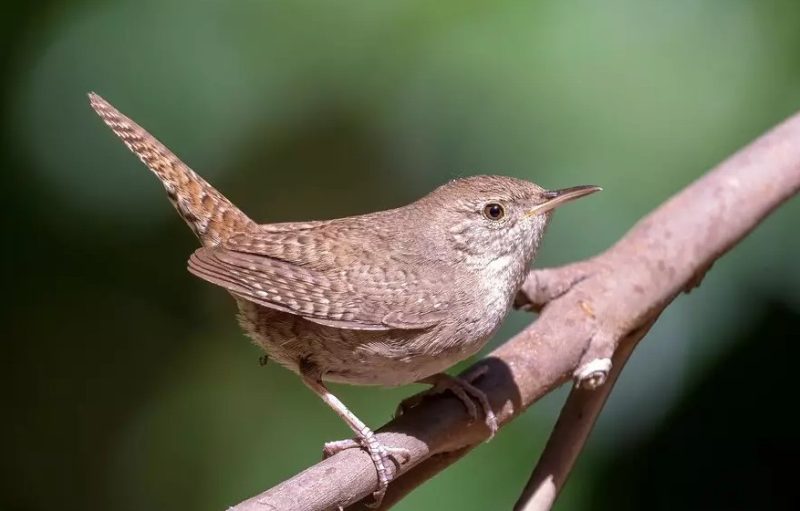
The House Wren is a common sight in Arkansas, known for its energetic presence in backyards despite rarely visiting feeders. This small, brown bird is characterized by its short tail, thin bill, and dark barring on wings and tail, with no visible difference between males and females.
House Wrens are often spotted darting through yards hunting insects and are attracted to brush piles. They’re notorious for nesting in unusual places, from clothespin bags to boots. Their distinctive song, a beautiful, energetic flute-like melody with rapid, squeaky chatters and rattles, is a key identifier.
Creating suitable habitats and listening for their unique vocalizations are effective ways to observe these adaptable and charming birds in Arkansas.
Mourning Dove
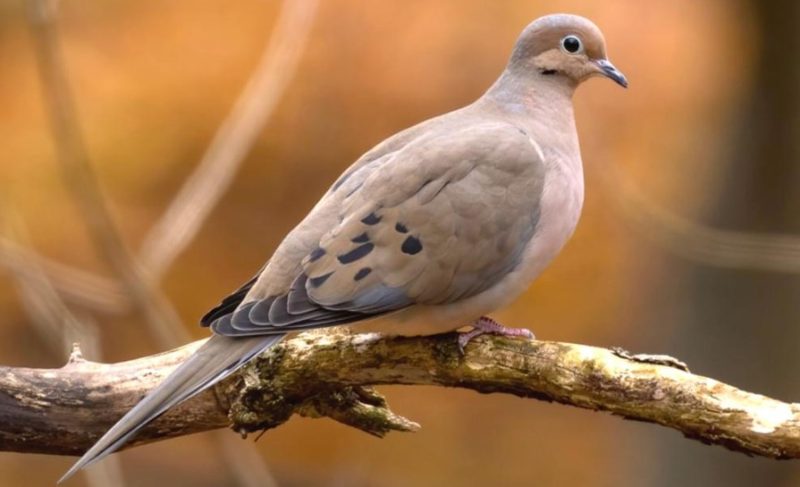
The Mourning Dove, Arkansas’s most common dove species, is easily recognizable by its grayish plumage, large black wing spots, and long, thin tail. Both sexes share pinkish legs, a black bill, and a distinctive blue eye-ring. Often seen perched on high wires or trees, they frequently feed on the ground.
These birds are regular visitors to feeding stations, favoring millet, shelled sunflower seeds, Nyjer seeds, cracked corn, and safflower. They prefer flat feeding surfaces, like trays or platforms. The Mourning Dove’s name comes from its distinctive low, mournful “coo-ah, coo, coo, coo” call, which is often mistaken for an owl.
Their widespread presence and unique vocalizations make them a familiar sight and sound in Arkansas’s diverse landscapes.
Rock Pigeon
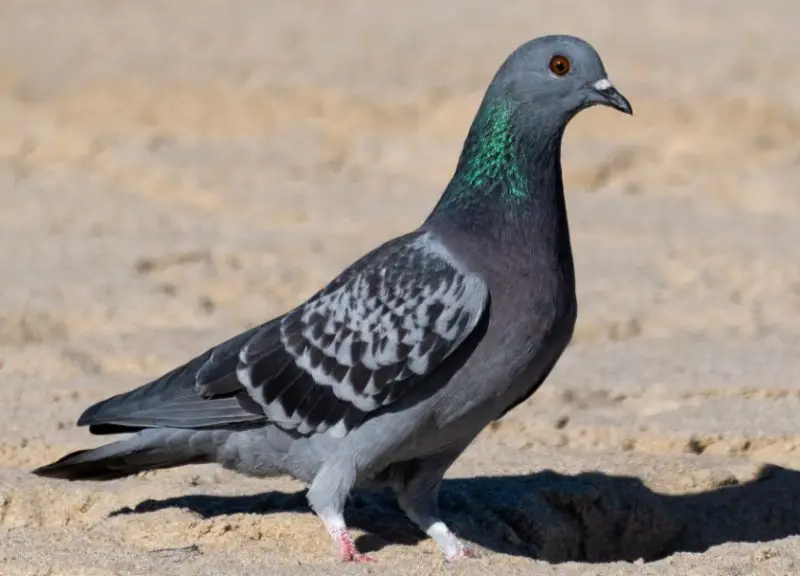
The Rock Pigeon, commonly known simply as “pigeon,” is a ubiquitous sight in Arkansas’s urban areas. These plump birds feature a small head, short legs, and a thin bill. While typically gray-backed with a blue-grey head and two black wing bars, their plumage can vary widely from all-white to rusty-brown.
Often seen in large flocks in city parks, they’re easily attracted to bird feeders and ground-scattered food. Their soft, throaty coos are instantly recognizable.
Rock Pigeons have a long history with humans, with evidence of domestication dating back over 5,000 years. Despite sometimes being considered a nuisance, these adaptable birds are an integral part of Arkansas’s urban ecosystems.
Northern Cardinal
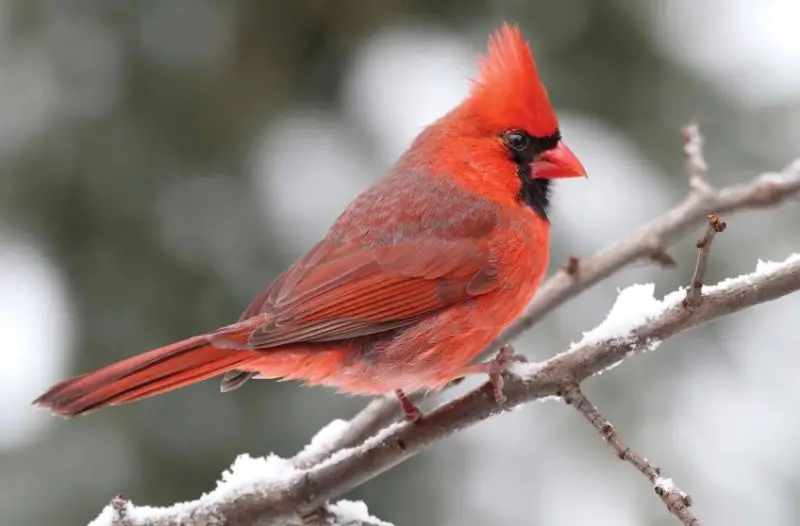
The Northern Cardinal is one of Arkansas’s most beloved and easily recognizable birds. Males are striking with their bright red plumage, black mask, and throat, while females display a more subdued pale orangish-brown coloration with red accents on their crest, wings, and tail. Both sexes feature a distinctive crest and a short, thick bill, perfect for seed-cracking.
These popular birds are frequent visitors to backyard feeders, attracted by sunflower seeds, safflower seeds, corn, and peanuts. Their presence is often announced by their clear, whistled melodies, which sound like “birdie-birdie-birdie” or “cheer-cheer-cheer”.
Uniquely, both male and female Northern Cardinals sing, adding to their charm in Arkansas’s diverse avian landscape.
Blue Jay
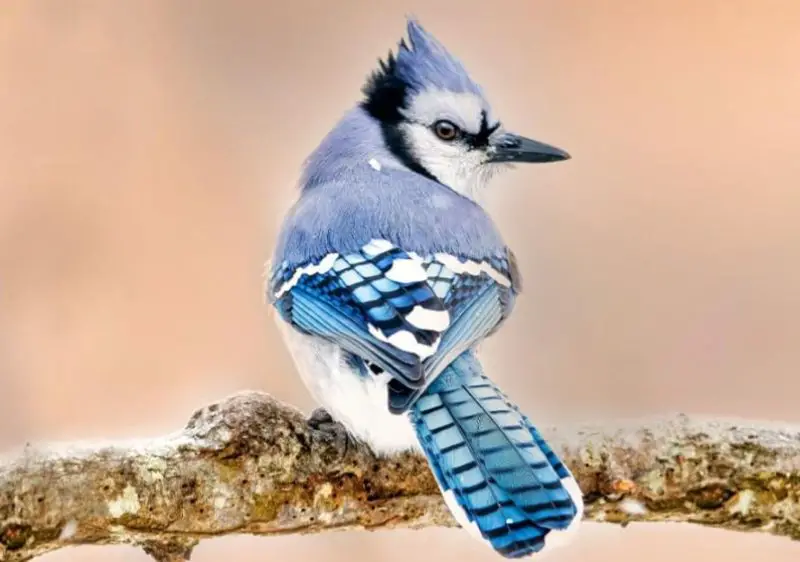
The Blue Jay is a striking and intelligent bird common in Arkansas. Easily recognizable by its vibrant blue back with black bars, white underparts, and distinctive blue crest surrounded by a black necklace, both males and females share this eye-catching appearance.
Known for their bold personalities and high intelligence, Blue Jays are frequent, albeit noisy, visitors to backyard feeders. They’re particularly fond of whole peanuts, sunflower seeds, and corn. Their vocalizations are diverse, with a common alarm call sounding like “jeer.”
Interestingly, Blue Jays are excellent mimics, often imitating hawk calls to deceive other birds. Their beauty, intelligence, and unique behaviors make them a fascinating species to observe in Arkansas’s diverse avian population.
Tufted Titmouse
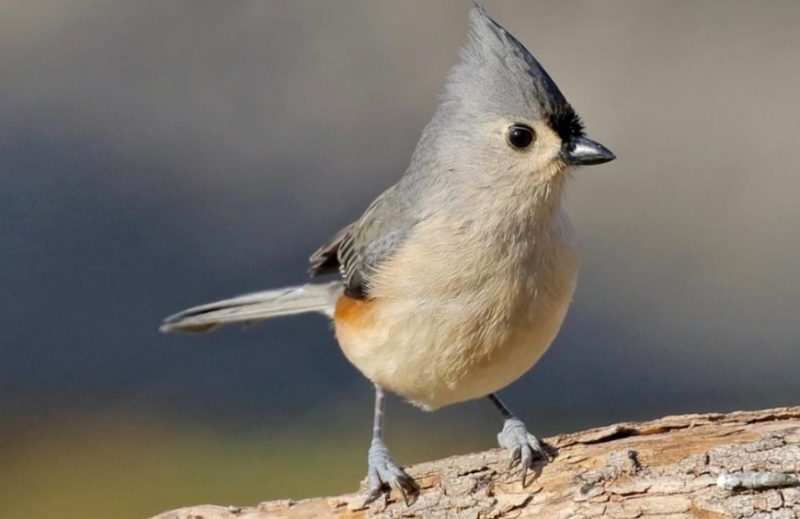
The Tufted Titmouse, a common sight in Arkansas’s deciduous forests, backyards, and city parks, is easily recognizable by its distinctive features. This grayish bird boasts white underparts, a peach wash on the sides, and a prominent crest atop its head. Both sexes share a black forehead and large, dark eyes.
Known for their acrobatic behavior, Tufted Titmice are often seen flitting between trees, hanging upside down or sideways while foraging. They’re regular visitors to bird feeders, especially in winter, favoring sunflower seeds, peanuts, and suet.
Their vocalizations are distinct, with a fast, repeated “peter-peter-peter” song and a scratchy “tsee-day-day-day” call. These charming birds add both visual and auditory interest to Arkansas’s diverse avian landscape.
Common Grackle
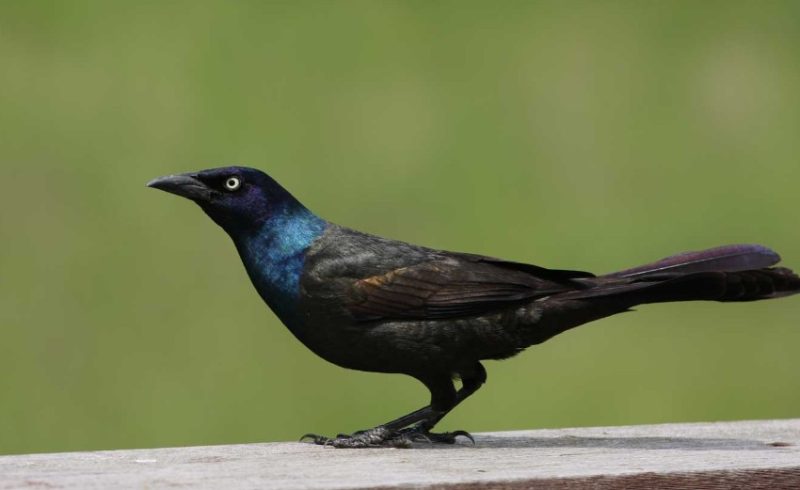
The Common Grackle is a large black bird with a long tail and a slightly downward-curving bill. They often gather in large flocks high in trees and are quite noisy. Males have an iridescent blue head and bronze body in the right light, while females are slightly less glossy. Their diet is diverse, ranging from grains and insects to small animals and even garbage.
Their song resembles a rusty gate, accompanied by whistles and groans. At feeding stations, Common Grackles often appear in large flocks, intimidating smaller birds. Their adaptability and varied diet make them a common sight in many areas.
Pileated Woodpecker
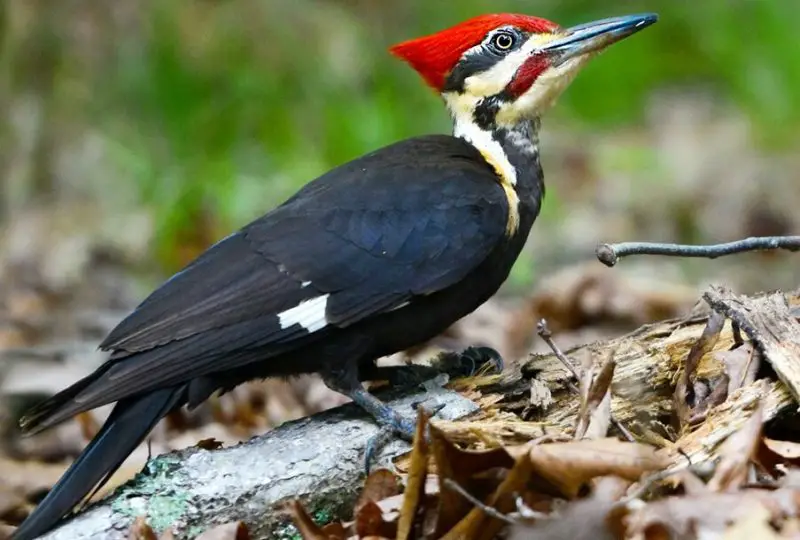
The Pileated Woodpecker is a striking, crow-sized bird, measuring up to 19 inches long with a 30-inch wingspan. Its most notable features are its large size and distinctive appearance. The bird is predominantly black, with white stripes on its face and neck and a prominent triangular red crest atop its head. Males have a red cheek stripe, while females have a black one.
These woodpeckers inhabit mature forests with dead and fallen trees, feeding mainly on insects in rotting wood. Their loud, rising, and falling “cuk-cuk-cuk-cuk-cuk” call is easily recognizable. Pileated Woodpeckers may visit backyard suet feeders, offering bird enthusiasts a chance to observe these impressive birds up close.
Red-bellied Woodpecker
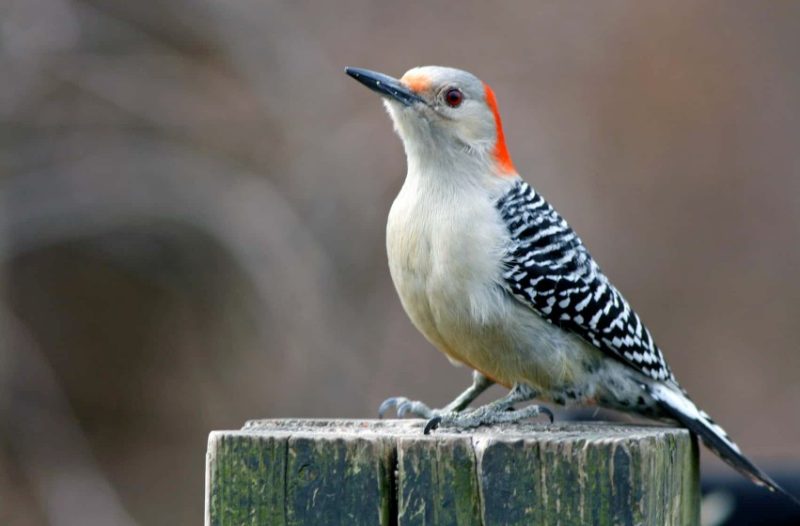
The Red-bellied Woodpecker, despite its name, is most recognizable by its black and white barred back and red head, not its belly. The red on their belly is actually a faint wash. Males have bright red plumage from their beak to the back of their neck, while females only have red on the back of their neck. This is the key difference between the sexes.
These woodpeckers are common visitors to feeders in Arkansas, attracted to peanuts, sunflower seeds, and suet. They’re often found in forests and wooded suburbs. Their distinctive call is a rolling “churr-churr-churr.” Learning this sound can help in identifying them even when they’re not visible.
Eastern Bluebird
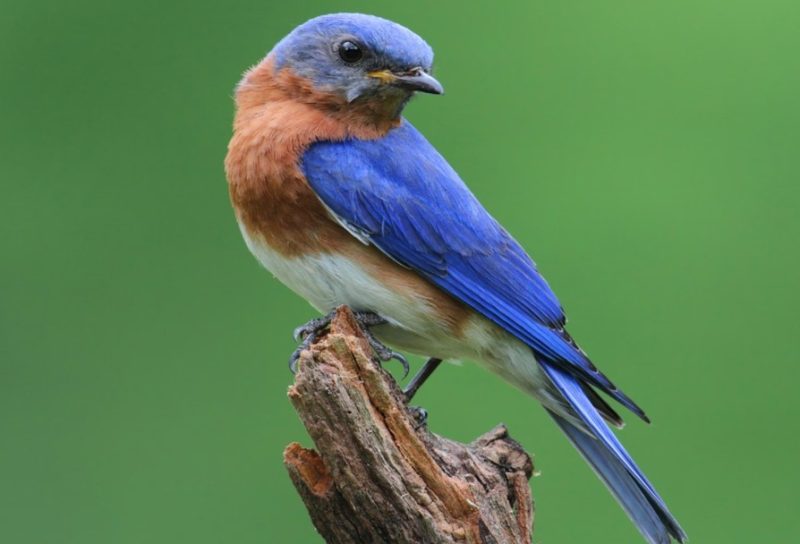
The Eastern Bluebird is a stunning bird species found in Arkansas. Males are easily identifiable by their vibrant blue plumage and rusty chest and throat. Females have similar markings but more subdued colors.
These cheerful birds frequent open areas like meadows, fields, golf courses, parks, and even backyards. They can be attracted to feeding stations with specific offerings, such as mealworms and berries.
Their call is distinctive – a liquid warbling song consisting of 1-3 notes, usually repeated several times. This beautiful song, combined with their striking appearance, makes the Eastern Bluebird a favorite among both seasoned birders and casual observers.
Ruby-throated Hummingbird

The Ruby-throated Hummingbird is a common summer visitor to Arkansas. Males are distinctive with their bright red throat, black chin and mask, and iridescent green head and back. Females are duller, lacking the red throat and instead having a white throat with pale green streaks.
These tiny birds are remarkable for their long migration, with most flying non-stop across the Gulf of Mexico to reach their winter grounds in Mexico.
They can often be heard making a chattering “chee-dit” call, especially when chasing each other. Despite their small size, Ruby-throated Hummingbirds are known for their territorial behavior and acrobatic flying skills.
Baltimore Oriole
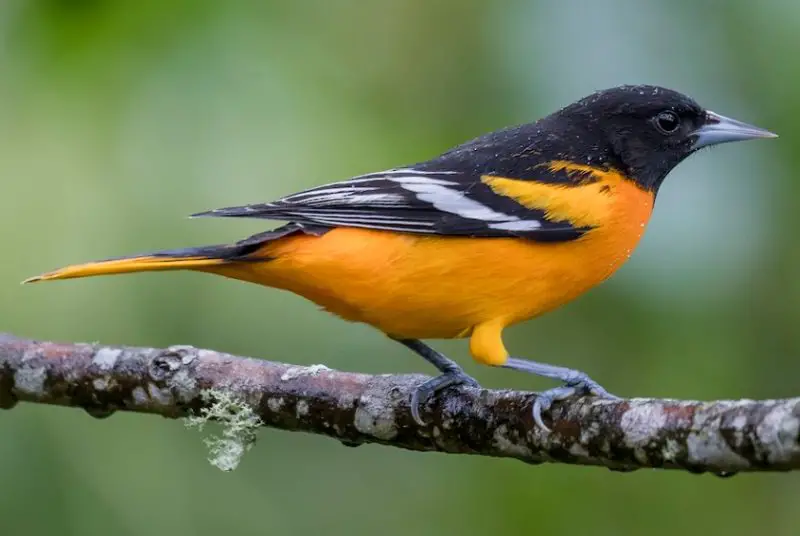
The Baltimore Oriole is a striking bird that heralds spring in Arkansas. Males are unmistakable with their vibrant orange and black plumage and white wing bars. Females are more subdued but still beautiful, lacking the black hood and back of males.
These birds prefer open woodlands, riverbanks, and forest edges, typically staying high in deciduous trees. They’re often heard before seen, with males producing a flutelike whistle and females making a shorter communication call.
Baltimore Orioles are attracted to feeders offering ripe fruit, jelly, and nectar. Their diet also includes insects for nutrition. Their distinctive appearance, melodious calls, and fondness for sweet foods make them a favorite among bird enthusiasts.
Chipping Sparrow
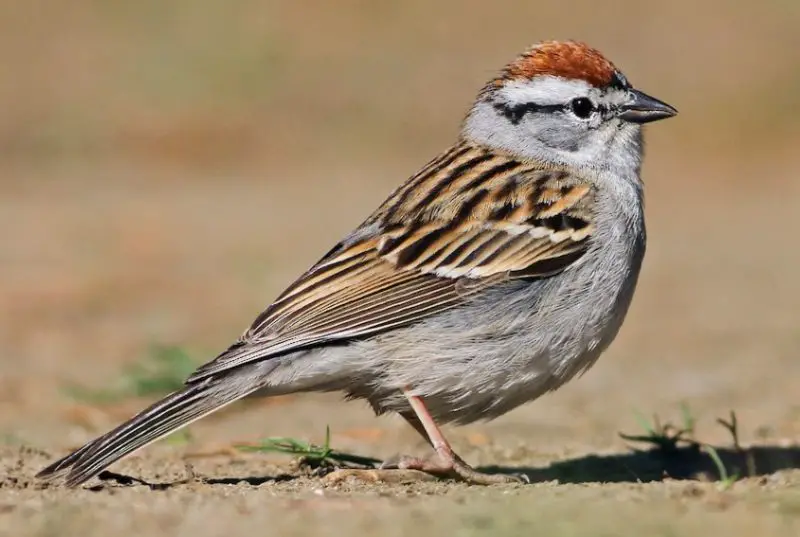
Chipping Sparrows are common in Arkansas and easily identifiable. They come in two main color variations: some are brightly colored with a rusty crown, grayish belly, and black-streaked eyeline, while others are paler with a brownish crown and unstreaked neck and belly. Both sexes are slim, with a long tail and a medium-sized bill.
These birds frequent woods near grassy meadows and suburban areas. They’re often seen at backyard feeders, particularly eating black oil sunflower seeds and seed mixes on the ground.
Their song is distinctive – a long, mechanical-sounding trill that’s repeated over and over, making them easy to identify by sound as well as sight.
Dark-eyed Junco
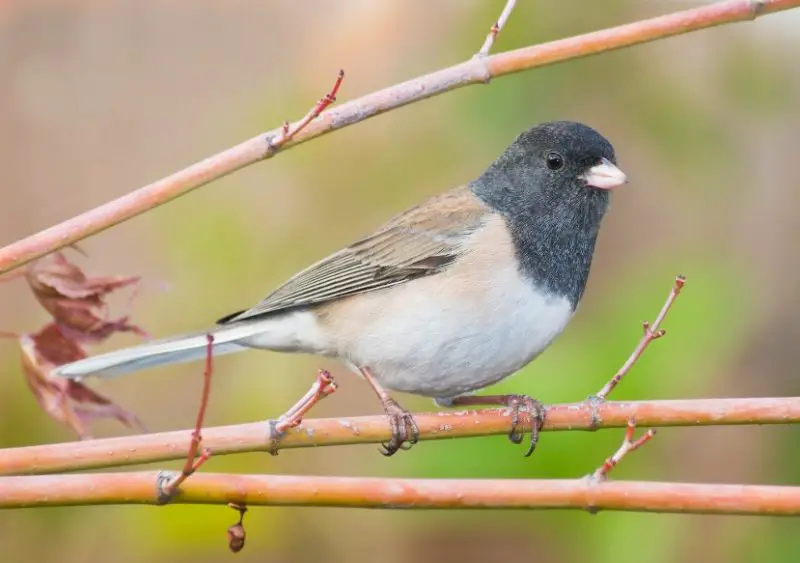
Dark-eyed Juncos are common winter visitors in Arkansas, often called “Snowbirds” or “Winter birds”. They’re easily identifiable by their smooth, soft-looking slate gray plumage with a white belly. Look for their small, pale bill and long tail, with white outer feathers that flash when they fly.
These birds prefer pine and mixed-coniferous forests for breeding but frequent fields, parks, woodlands, and backyards in winter. At feeders, they’re strictly ground feeders, consuming fallen seeds.
Males have a loud, musical trilling song lasting about two seconds. Both sexes also produce softer songs, mixing warbles, trills, and whistles. Their appearance and behavior make them a distinctive winter presence.
Pine Siskin
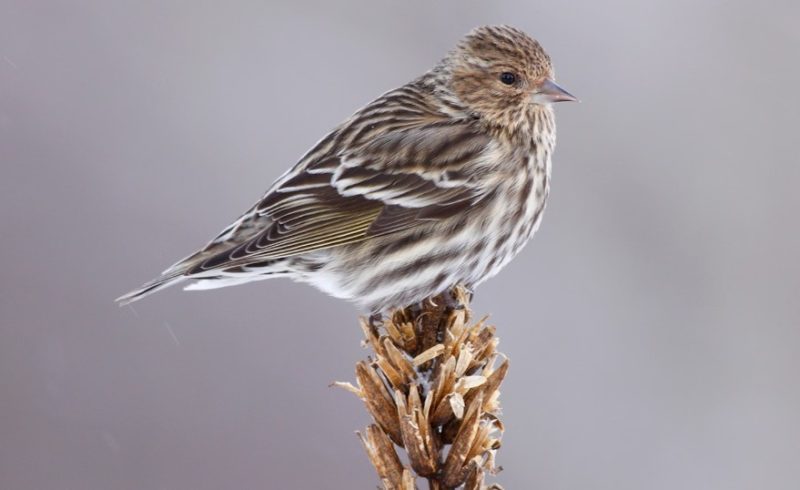
Pine Siskins are small, brown, streaked finches with distinctive yellow edging on their wings and tails. Both sexes look identical, unique among Arkansas finches. They have sharply pointed bills, short forked tails, and long pointed wingtips.
These social birds are found in mixed forests but may visit weedy fields, backyards, or gardens when searching for food. In winter, they frequent bird feeders, preferring smaller seeds like sunflower or Nyjer.
Pine Siskins are known for their constant chirping, even while flying. Their song is a twittering warble that rises and falls, occasionally interspersed with a rising “ZZZzzzzzreeee.” Their wheezy sound distinguishes them from other Arkansas finches.
Rose-breasted Grosbeak
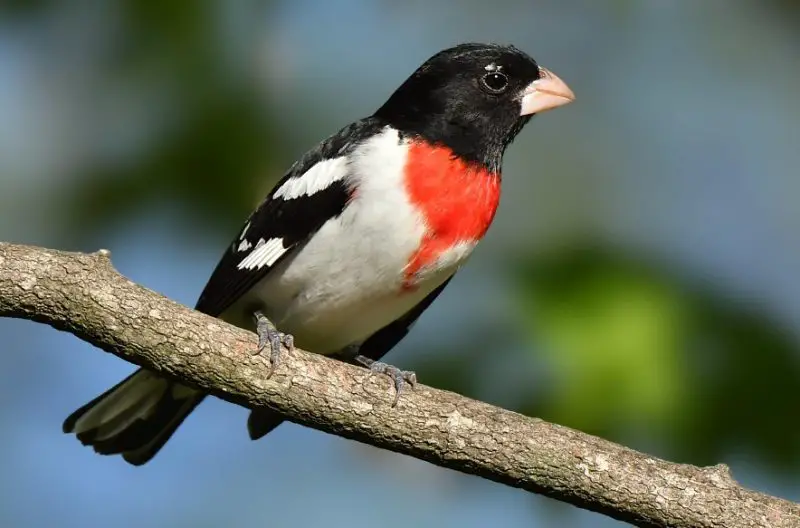
Rose-breasted Grosbeaks are stocky birds about the size of an American Robin, with large, triangular bills. Males are striking, with black backs and wings and a distinctive red mark on their white breasts. Females are heavily streaked brown with a white eyebrow and pale bill.
These birds often visit feeders, particularly sunflower seeds on platform feeders. Their large bills are perfect for cracking open seeds.
Male Rose-breasted Grosbeaks are known for their beautiful song, similar to but more melodious than an American Robin’s. It consists of a long series of rising and falling notes, often sung from an elevated perch.
White-crowned Sparrow
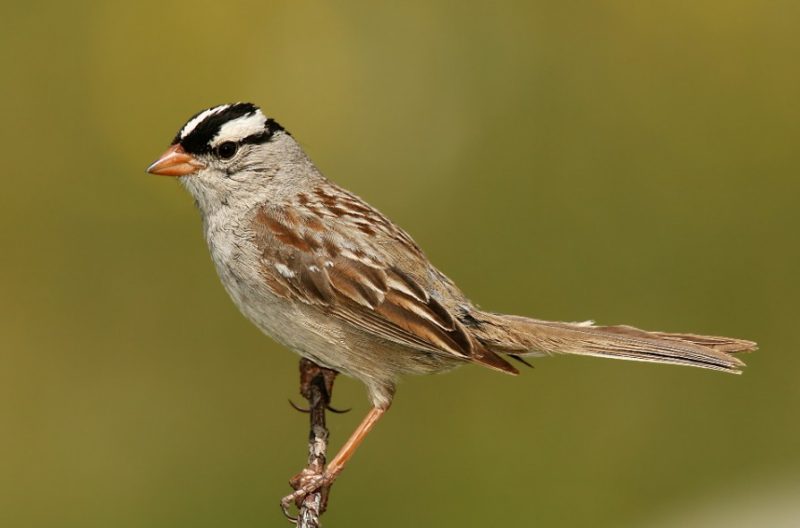
White-crowned Sparrows are medium-sized birds with grayish or brownish bodies and long tails. Their most distinctive feature is their striped head, which can be black and white or brown and tan, with a peaked crown. They have orangish-yellow or pinkish bills.
These sparrows prefer shrubby habitats with open grassy areas during breeding season, and weedy fields, thickets, and backyards in winter. They’re ground feeders, attracted to sunflower seeds scattered on the ground or near brush piles.
White-crowned Sparrows are known for their impressive migration, capable of traveling over 300 miles in a single night. Their song, primarily sung by males, is brief, lasting only a few seconds.
White-throated Sparrow
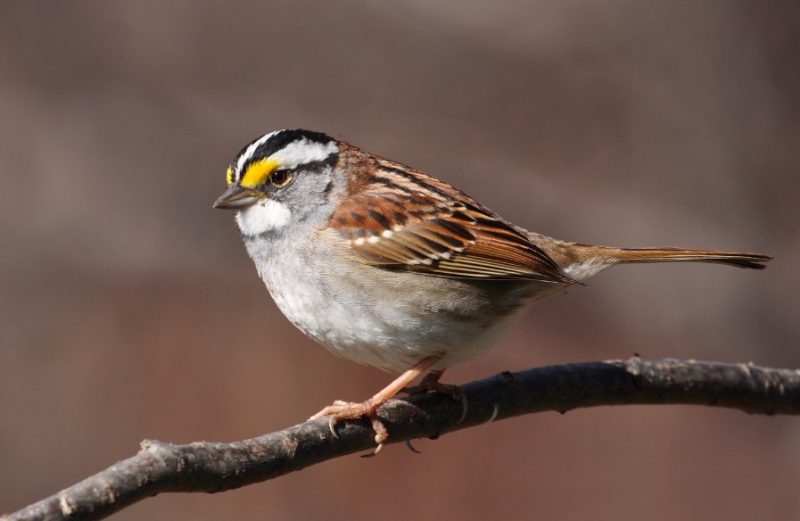
White-throated Sparrows are chunky birds with colors varying from gray to tan. Their distinctive features include a black and white striped head, a yellow spot between the eyes, a white throat patch, gray face, and small bill.
These sparrows are often found along forest edges in Arkansas, foraging on the ground by scratching or moving leaves with their bill. They readily visit bird feeders, preferring sunflower seeds or millet scattered on the ground near thickets for safety.
Their song is a high-pitched whistle that sounds like “Oh-sweet-Canada-Canada,” making them easy to identify by ear.
Gray Catbird
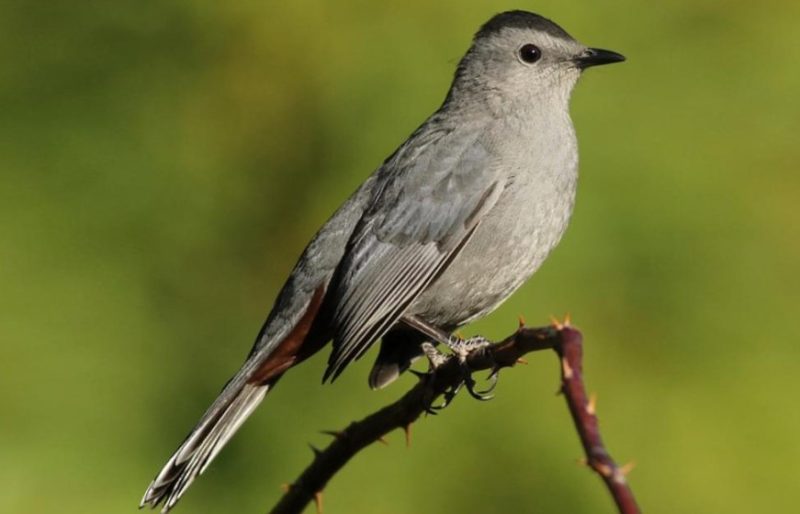
Gray Catbirds are distinctive birds with an overall gray plumage and a black cap. Their most notable feature, however, is their vocal ability. They’re known for mimicking the songs of many other birds, making them fascinating to listen to.
Their common call is easy to identify – a raspy, cat-like “meow,” which gives them their name. If you hear what sounds like a cat in a dense thicket, it’s likely a Gray Catbird.
These birds can be attracted to feeders with an unusual treat: grape jelly. Setting out small cups of grape jelly can entice Gray Catbirds to visit your yard regularly.
Northern Mockingbird
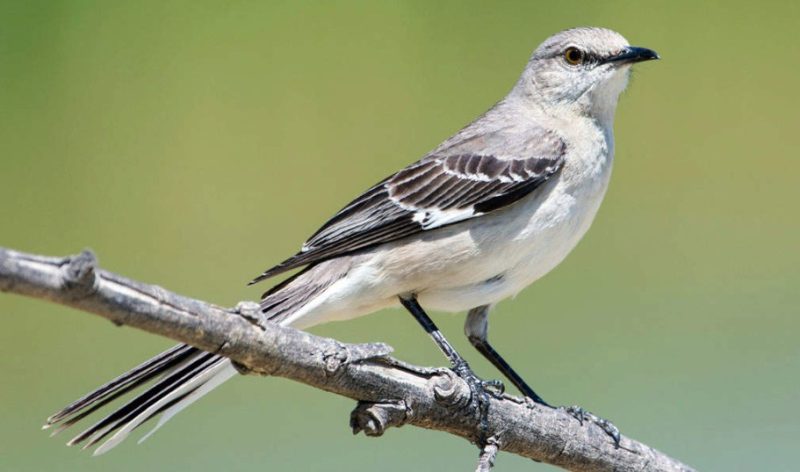
Northern Mockingbirds are medium-sized gray songbirds with distinctively long, slender tails and white wing patches visible in flight. They’re hard to miss in Arkansas, not just for their appearance but for their behavior.
These birds are renowned for their vocal abilities, singing almost constantly, sometimes even through the night. Their songs often mimic those of other birds and even mechanical sounds.
Northern Mockingbirds have bold personalities, often harassing other birds by flying around them with wings raised to display their white patches.
While common in backyards, they rarely eat from feeders. However, they may scare away other birds from feeding stations, showcasing their territorial nature.
Red-breasted Nuthatch
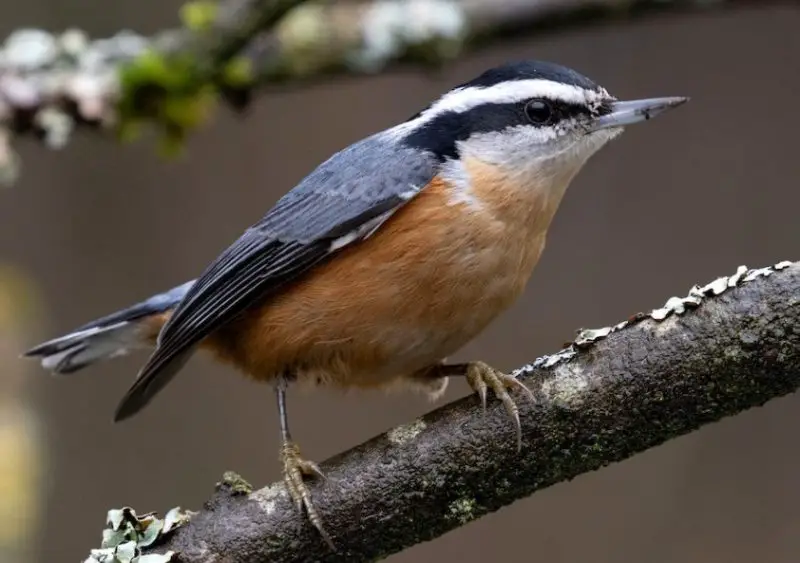
Red-breasted Nuthatches are small, active songbirds with compact bodies, almost no neck, and very short tails. They have distinctive coloring and are known for their ability to walk headfirst down tree trunks.
These birds breed in northern North America but can be found in various locations during winter, sometimes as far south as the Gulf of Mexico. In Arkansas, they’re mostly found in coniferous forests.
Their call is unique – a fast series of nasally “yank-yank-yank” sounds, often compared to a toy tin horn. This call is typically made by males seeking a mate.
Carolina Wren
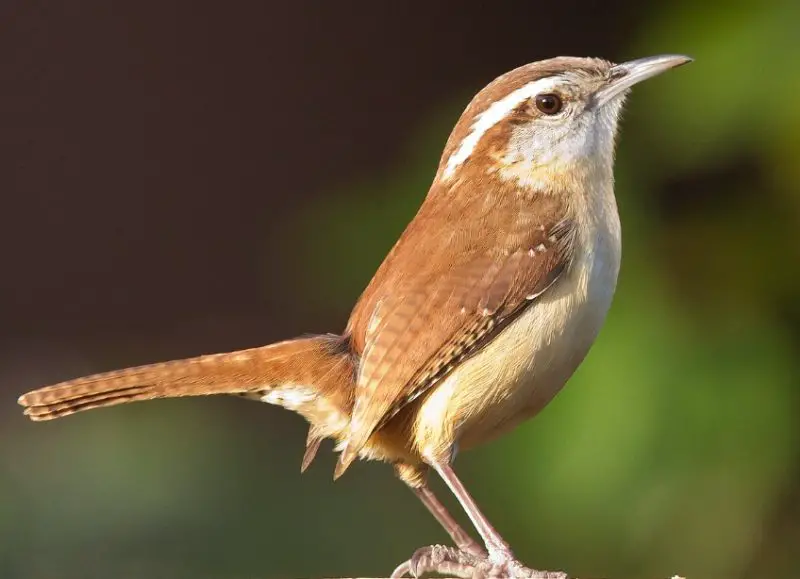
Carolina Wrens are colorful reddish-brown birds with distinctive white throats and eye lines. They have darkly barred wing and tail edges and long, thin bills. Both sexes look similar.
Despite being common in Arkansas, their secretive nature makes them challenging to spot. They prefer shrubby, bushy areas with plenty of hiding spots.
These wrens are more likely to visit feeders in winter, favoring suet, peanuts, shelled sunflower seeds, and mealworms. In summer, they primarily eat insects.
Carolina Wrens are known for their loud, distinctive song. Males sing a three-parted “tea-kettle tea-kettle tea-kettle,” with many variations.
Great-tailed Grackle

The Great-tailed Grackle is a striking and increasingly common bird in Arkansas. Males are easily identifiable by their large size, slender build, long legs, and iridescent black plumage, complemented by bright yellow eyes and a distinctively long V-shaped tail. Females, about half the size of males, have dark brown upperparts and paler brown underparts.
These brash birds are often seen in large flocks, adapting well to human environments such as parks, farms, landfills, and backyards, as well as their natural habitats of open forests, marshes, and chaparral.
Their rapid expansion across North America, particularly in agricultural and urban areas, makes them one of the continent’s fastest-spreading species, adding a dynamic element to Arkansas’s avian population.
American Robin
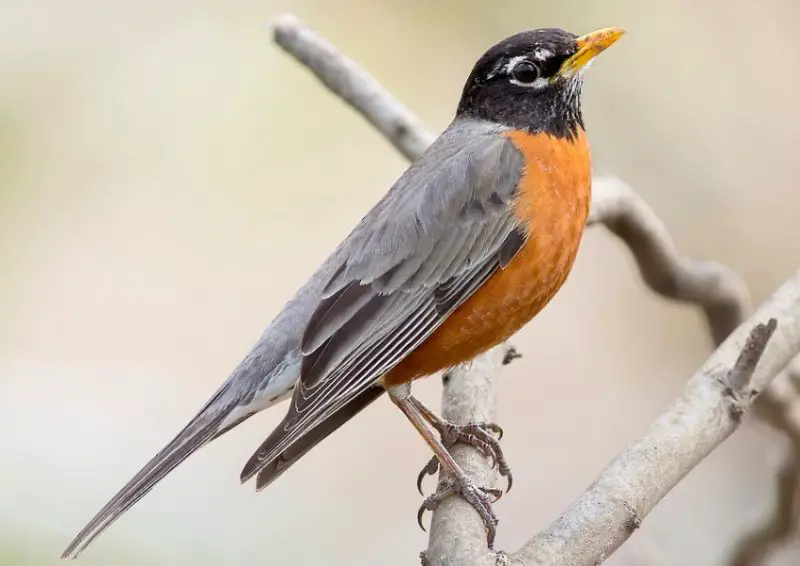
The American Robin is a common and easily recognizable bird in Arkansas. Its distinctive features include a rusty red breast, a dark head and back, a white throat, and white splotches around the eyes. Females appear slightly paler than males. These adaptable thrushes are found in various habitats, from forests to urban areas, and are frequent visitors to backyards.
Although they rarely visit bird feeders, American Robins can often be seen foraging for worms and insects on lawns. Their nests are open and cup-shaped, containing 3–5 sky-blue eggs. The Robin’s song is a familiar spring sound, consisting of clear whistles often described as “cheerily, cheer up, cheer up, cheerily, cheer up.”
Downy Woodpecker
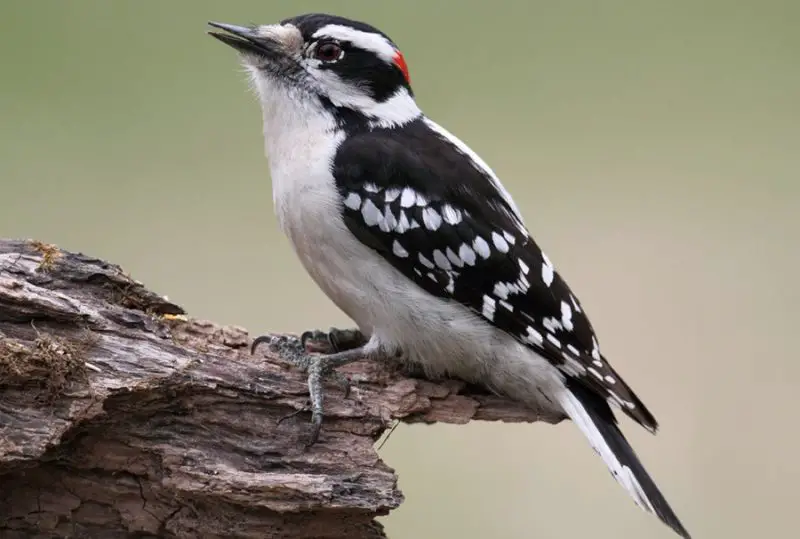
The Downy Woodpecker, one of Arkansas’s most common birds, is easily recognizable by its distinctive features. This small woodpecker has a short bill, a white belly, and a mostly black back adorned with white streaks and spots. Male Downy Woodpeckers are distinguished by a red spot on the back of their heads, which females lack.
Frequently seen in backyards, these birds are readily attracted to feeders offering suet, sunflower seeds, and peanuts. They may even sip sugar water from hummingbird feeders. Their call is a high-pitched whinnying sound that descends in pitch. Once you’re familiar with their appearance and call, you’ll likely notice Downy Woodpeckers everywhere in Arkansas.
Hairy Woodpecker
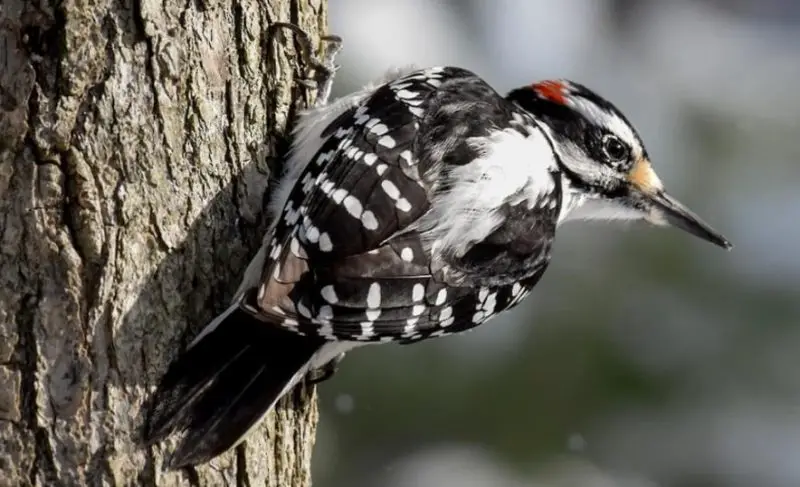
The Hairy Woodpecker, a common sight in Arkansas’s mature forests and suburban areas, is characterized by its striped head and erect posture on trees. Its black and white body features a long, chisel-like bill, with males distinguished by a red patch on the back of their heads.
Often confused with the Downy Woodpecker, the Hairy is larger (9–11 inches long) and has a bill nearly as long as its head. Its outer tail feathers are completely white, unlike the Downy’s spotted ones.
Found wherever large trees are abundant, Hairy Woodpeckers inhabit diverse environments, from swamps to urban parks. Their size and bill length are key features for accurate identification.
American Goldfinch
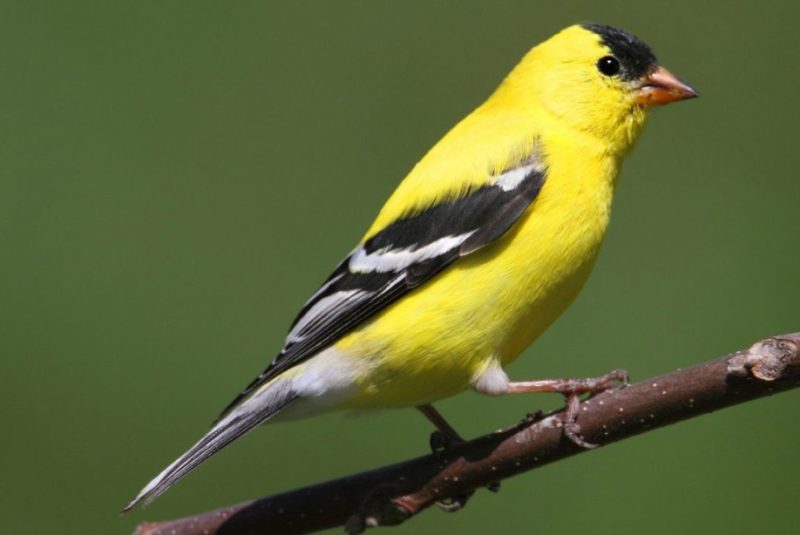
The American Goldfinch, a common sight in Arkansas, is known for its seasonal color changes. In summer, males sport vibrant yellow plumage with a black cap and wings, while females are duller yellow without the cap.
Winter transforms both sexes to a pale brown/olive color with black wings and a white wing bar. These small, vegetarian birds prefer Nyjer seeds and sunflower kernels, often using specially designed feeders to avoid competition with larger birds.
Their diet of exclusively seeds influences their late breeding season in June or July. Listen for their musical trills and warbles to identify them by sound. American Goldfinches are easily attracted to backyards with the right feeders and seeds.
House Sparrow
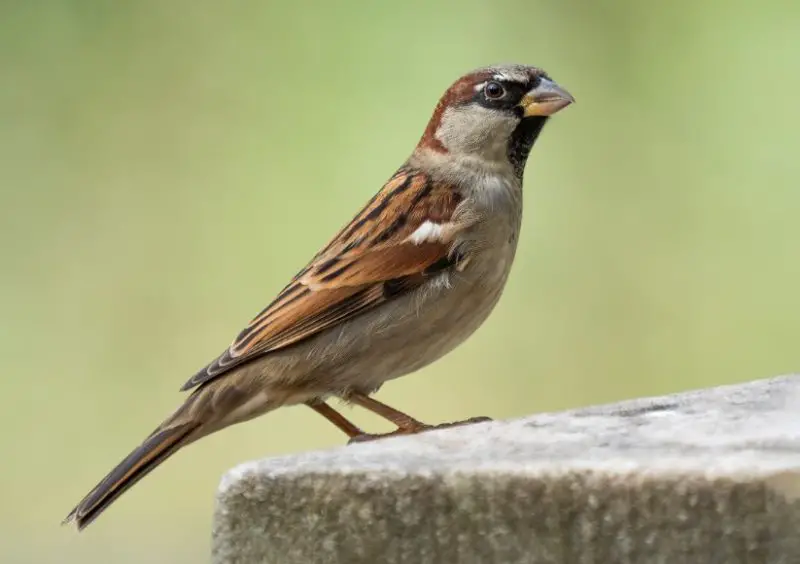
The House Sparrow, an invasive species originally from the Middle East, is now one of the most abundant birds in Arkansas and worldwide. Males are distinguished by their gray crowns, black bibs, white cheeks, and chestnut markings on the face and neck, with brown backs streaked with black.
Females are duller, featuring brown plumage with black-streaked backs and a distinctive tan line behind the eye. These adaptable birds thrive in urban and suburban environments, often competing with native species for nesting sites.
They’re frequently seen at bird feeders, favoring grains like cracked corn, millet, and milo. Their ubiquitous presence is marked by a simple song composed of repeated “cheep” notes, heard in diverse settings globally.
House Finch
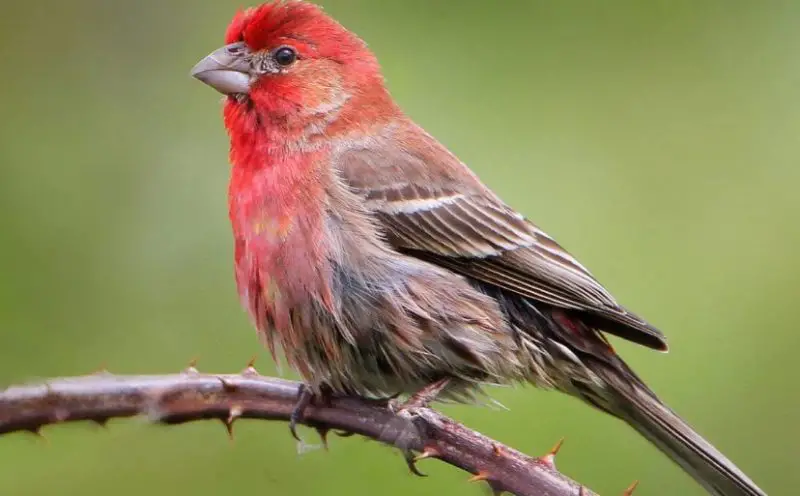
The House Finch is a common sight in Arkansas’s urban and suburban areas. Males are easily identifiable by their rosy red heads and upper breasts, contrasted with brown-streaked backs, tails, and bellies. Females, while less colorful, share the brown streaking pattern. Both sexes feature conical beaks adapted for seed consumption and notched tails.
These social birds are often the first to discover new feeders, preferring sunflower, Nyjer, and safflower seeds. House Finches are frequently spotted around buildings, backyards, and parks. Their presence often attracts other bird species to feeders.
Listen to their pleasant, year-round song consisting of a series of warbled notes, adding a melodious touch to Arkansas’s urban soundscape.

